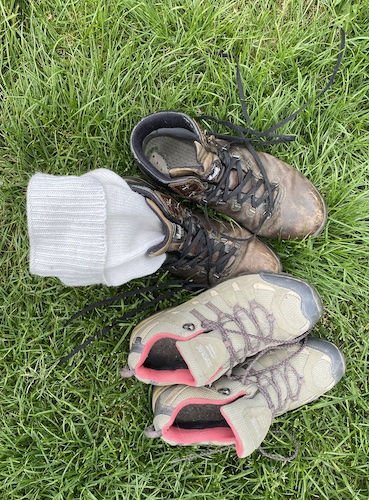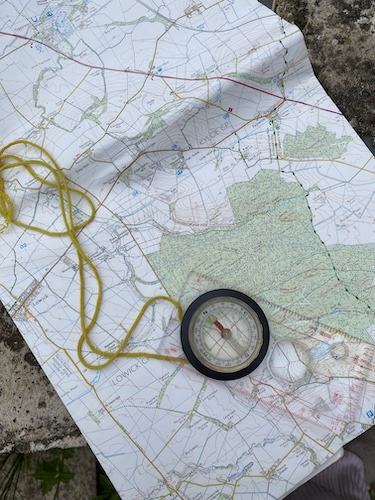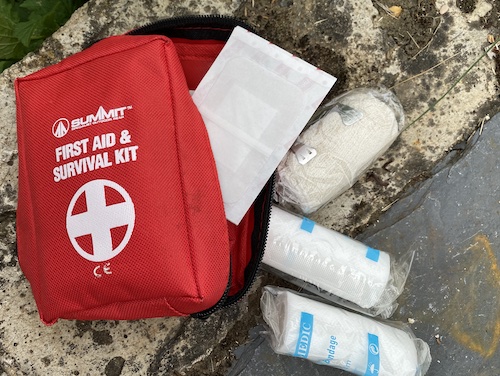- Home
- Nature Walk Checklist
A Nature Walk Checklist
A nature walk checklist is essential for preparing for an upcoming outdoor excursion.
Whether you're planning a short day hike in a local park or an extended backpacking trip in remote wilderness, having the right gear and supplies can make all the difference in ensuring a safe, comfortable and rewarding experience.
Hiking unprepared in the wild can lead to serious problems. Many of these emergencies could be avoided with proper planning and equipment. Even on shorter outings, being ready for changing weather, rough terrain, and unexpected challenges is crucial.
Two key areas to focus on are footwear and clothing.
Footwear

Investing in quality, durable hiking boots or trail shoes is one of the most important gear choices.
Proper footwear provides essential support, traction, and protection on uneven surfaces and in inclement conditions.
REI, a leading outdoor retailer, recommends boots with the following features for multi-day hikes:
- Sturdy, thick soles with aggressive tread for grip
- Durable, waterproof materials like leather or Gore-Tex
- Shanks or plates in the midsole for stability and protection against rocks and roots
- Mid-to-high cut to support the ankles
Moisture-wicking wool or synthetic socks are also key for blister prevention and comfort. Brands like Darn Tough and Smartwool offer padded options popular with distance hikers. (affiliate links).
Clothing
Dressing in layers allows you to adapt to changing temperatures and exertion levels. The core components are:
- A breathable, quick-drying base layer to manage moisture
- An insulating mid-layer like fleece or down
- A waterproof/windproof outer shell to protect from the elements
For the outer layer, look for a jacket made with a trusted waterproof-breathable fabric like Gore-Tex, eVent or NeoShell.
Fully-taped seams, adjustable hoods, and ventilation zips are other useful features.
Your colour choice depends on the environment and activity.
For wildlife viewing, neutral earth tones help you blend in - some photographers even use camouflage ghillie suits to avoid detection. Both my husband and I have Jack Pike jackets with camouflage patterned fabric, along with multiple pockets.
In contrast, for high-altitude mountaineering or solo trips in remote areas, bright colours enhance visibility for safety. Guides often wear red for easy identification.
Poles or Sticks
High-quality trekking poles, such as those made by Black Diamond or Leki, can reduce the impact on your knees by up to 25% according to a study by the Journal of Sports Sciences. They help support your upper body and maintain balance when traversing uneven ground, crossing streams, or navigating steep inclines or declines.
For photographers, a sturdy monopod like the Manfrotto Element can double as a walking stick. It not only provides stability on the trail but can also be used to steady your camera for sharper shots in low light conditions.
Backpack
A well-designed backpack is a must-have for any hiker. Look for models with a capacity between 20-35L, which is sufficient for day hikes while allowing room for essential gear.
REI's Trail 25 pack is a top pick, featuring an adjustable suspension system, padded hip belt, and a built-in rain cover.
Key features to consider:
- Ergonomic shoulder straps and hip belts that distribute weight evenly
- Multiple compartments and pockets for organization, including a separate hydration sleeve that can hold a 3L reservoir
- Durable, water-resistant materials like ripstop nylon
- Ventilated back panel to reduce sweat and improve comfort
Printing out this nature walk checklist and storing it in your pack ensures you never forget crucial items.
Camera Bag
Photographers investing in high-end gear need a dedicated pack to protect their equipment.
Look for these essential camera bag features:
- Adjustable, padded inserts to hold various lens sizes securely
- Multiple access points, like side doors, to quickly grab gear without fully opening the bag
- Weatherproof zippers and rain cover for harsh conditions
- Lockable compartments to stow valuables during travel
- Attachment points for a travel tripod
By investing in quality, feature-rich packs, hikers and photographers can focus on capturing stunning wilderness shots without worrying about their gear.
Compass and Map
 Compass and ordinance survey map
Compass and ordinance survey mapA high-quality compass and detailed topographic maps are essential tools for any hiker venturing into unfamiliar terrain, even when using GPS.
Keep paper maps protected in a waterproof plastic bag or laminate them for durability in wet conditions.
While handheld GPS devices like the Garmin eTrex 22x can be incredibly useful for navigation, it's crucial to remember that batteries can unexpectedly die during a trek.
You don't want to become a statistic and need rescuing because you relied soley on GPS without a backup navigation method, do you?
Always keep your cellphone fully charged and easily accessible for emergency calls.
Before leaving home, save a link to this nature walk checklist on your home screen for quick reference.
Headlamp or Flashlight
Prioritize your safety by carrying a reliable headlamp or flashlight. These powerful lights can illuminate up to 100 meters ahead, lasting 12-50 hours on a single charge. When hiking near dusk or dawn, wear outer garments with reflective elements to increase visibility in low-light conditions.
Pay close attention to your footing and avoid hiking after sunset or before sunrise whenever possible. If you must navigate in the dark, stay on clearly marked trails and never wander off alone. You might be surprised to learn that 48% of search and rescue incidents occur between 4pm and 8am, when visibility is reduced.
First Aid Kit and Medication
 Our first aid kit
Our first aid kitAlways pack a well-stocked first aid kit to self-treat injuries or ailments on the trail.
Include essentials like safety pins, bandages, antiseptic wipes, and gauze for treating cuts, grazes, and blisters.
If you require regular medication, pack enough for your expected trip duration plus an extra 2-3 days' supply in case of unexpected delays.
Depending on the season and location, add insect repellent containing at least 20% DEET or picaridin to your nature walk checklist.
Here in the UK we don't have to worry about large animals such as bears, but if you are hiking where they could be in the vicinity carrying bear spray is sensible.
Food and Water
Even if you are only planning a short 2-3 mile hike, packing nutritious snacks like trail mix, energy bars, or fresh fruit is always wise.
This is especially critical if you have specific dietary needs - for example, if you have diabetes, like me, and need to carefully monitor blood sugar, or have food allergies or intolerances and must avoid certain ingredients.
Packing your own safe, suitable food ensures you won't need to rely on finding appropriate options in remote areas.
Staying hydrated is also key, especially in warm weather when experts recommend drinking at least 0.5 liters of water per hour of hiking.
Carrying a reusable, BPA-free water bottle and sipping regularly can prevent a dry throat and coughing fits that may scare off the wildlife you hope to photograph or observe. For longer treks, consider a hydration bladder that holds 2-3 liters and allows easy, hands-free drinking.
Ready for Emergencies
A loud whistle is an essential safety tool that allows you to signal for help from anywhere along the trail. The universal SOS signal is 3 long blasts, 3 short blasts, then 3 long blasts. Quality whistles can be heard over a mile away and even underwater.
Including a sturdy, multi-purpose pocket knife in your pack enables quick cutting of fruit, opening food packets, making kindling, or self-defense if needed.
Experts recommend a 3-4 inch locking or fixed blade made from rust-resistant steel with textured, non-slip grips.
In addition to your nature walk checklist, remember the following!
Tell Someone Where You Are Going
Whether hiking solo or in a group, always provide a detailed itinerary to a trusted friend or family member. Include the trail name, your start time, expected end time, and any planned stops.
Carry identification and emergency contact info in case you are injured and unable to speak to rescuers. Many hikers use lightweight ID bracelets or dog tags, or simply put a card or note in their pack's top pocket. If running behind schedule, having a physical copy of your itinerary allows you to update any pre-booked lodgings and avoid unnecessary worry or premature search efforts.
Look After the Environment
Glass bottles, aluminum cans, and other waste can be deadly to wildlife if left behind in nature.
Animals can die from becoming entangled or trapped in litter.
Always carry your waste out with you for proper disposal later. Use designated bins when available or seal waste in bags to pack out - but never tie bags to trees, as birds may incorporate them into nests, leading to injury or death.
Picking flowers or foliage in the wild can disrupt delicate ecosystems.
In the UK, wildflower meadows have declined by 97% since the 1930s, with many species now endangered. The once-common summer gentian, for example, is now found in only a handful of sites.
Admire plants in their natural habitat, take pictures, but avoid picking to allow others to enjoy their beauty.
Avoid Disturbing Nesting Birds or Animals
When coming upon nesting birds or animals, observe from a respectful distance to avoid disturbing them or attracting predators.
A keen birdwatcher once excitedly approached a nest for a photo, only to watch in dismay as a fox snatched the eggs moments later when the adult fled.
Animals have a natural instinct to protect their young, so do not approach them too closely as they can become aggressive and attack you. The biggest bird we have to watch out for here in the UK is the mute swan, which will even attack it's own kind!
Do not feed the wildlife or leave food out to attract them.
Your takeaways
By focusing on critical gear areas and features, you can assemble a nature walk kit that will serve you well in a variety of settings and situations. Investing up front in quality, fit-for-purpose equipment pays off in the long run in terms of comfort, performance and preparedness.
Did I miss something from the nature walk checklist?
Further Reading
What to Do on Your Walk
How to Identify Wild Birds - Learn how to identify wild birds by shape, sound, size and behaviour – even if you're brand new to birding!
Getting Into with Wildlife Photography - Learn about the right gear, techniques, and tips to capture stunning shots of wildlife, even as a beginner.
How to Start Wildlife Photography - Wondering how to start wildlife photography? Learn how to plan your shoot, spot wildlife, and compose beautiful photos—without stress or overwhelm.
Suggestions for Your First Walk
Barnwell Country Park - A review of Barnwell Country Park, Northamptonshire and the wildlife that can be seen and photographed when visiting including kingfishers and otters.
Fermyn Woods Country Park - Fermyn Woods Country Park is an ideal place for a nature walk.
Best Walks in Northamptonshire - Explore the best walks in Northamptonshire—spot kingfishers, butterflies, and wildflowers in peaceful woodlands and river trails.

About the Author
For me, it’s never been just about bird names or camera settings, but the thrill of seeing a distant speck turn into a hunting kestrel.
After years of learning how to notice and photograph those moments, my camera has become the tool - and this site the field notebook - where I share what I’ve discovered.
If you’re ready to look a little closer, you’ll find the trips, lessons, and small wins that can help you see and photograph the wildlife right on your doorstep.
Step Behind the Wild Lens
If you’ve enjoyed your time here, you can also follow along by email.
I send the Wild Lens newsletter occasionally. It’s where I share:
- Fresh field notes and recent encounters
- The stories behind favourite photos
- Practical tips that don’t always make it onto the site
You’ll get new UK wildlife guides, photo tips, and ideas for your next walk, straight to your inbox.
